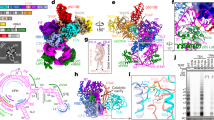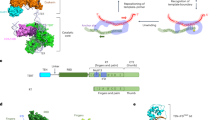Abstract
Telomerase is required to maintain repetitive G-rich telomeric DNA sequences at chromosome ends. To do so, the telomerase reverse transcriptase (TERT) subunit reiteratively uses a small region of the integral telomerase RNA (TER) as a template. An essential feature of telomerase catalysis is the strict definition of the template boundary to determine the precise TER nucleotides to be reverse transcribed by TERT. We report the 3-Å crystal structure of the Tetrahymena TERT RNA-binding domain (tTRBD) bound to the template boundary element (TBE) of TER. tTRBD is wedged into the base of the TBE RNA stem-loop, and each of the flanking RNA strands wraps around opposite sides of the protein domain. The structure illustrates how the tTRBD establishes the template boundary by positioning the TBE at the correct distance from the TERT active site to prohibit copying of nontemplate nucleotides.
This is a preview of subscription content, access via your institution
Access options
Subscribe to this journal
Receive 12 print issues and online access
$189.00 per year
only $15.75 per issue
Buy this article
- Purchase on Springer Link
- Instant access to full article PDF
Prices may be subject to local taxes which are calculated during checkout






Similar content being viewed by others
References
Palm, W. & de Lange, T. How shelterin protects mammalian telomeres. Annu. Rev. Genet. 42, 301–334 (2008).
Allsopp, R.C. et al. Telomere length predicts replicative capacity of human fibroblasts. Proc. Natl. Acad. Sci. USA 89, 10114–10118 (1992).
Greider, C.W. & Blackburn, E.H. The telomere terminal transferase of Tetrahymena is a ribonucleoprotein enzyme with two kinds of primer specificity. Cell 51, 887–898 (1987).
Vulliamy, T.J. & Dokal, I. Dyskeratosis congenita: the diverse clinical presentation of mutations in the telomerase complex. Biochimie 90, 122–130 (2008).
Kim, N.W. et al. Specific association of human telomerase activity with immortal cells and cancer. Science 266, 2011–2015 (1994).
Licht, J.D. & Collins, K. Telomerase RNA function in recombinant Tetrahymena telomerase. Genes Dev. 13, 1116–1125 (1999).
Greider, C.W. & Blackburn, E.H. A telomeric sequence in the RNA of Tetrahymena telomerase required for telomere repeat synthesis. Nature 337, 331–337 (1989).
Lue, N.F. A physical and functional constituent of telomerase anchor site. J. Biol. Chem. 280, 26586–26591 (2005).
Romi, E. et al. High-resolution physical and functional mapping of the template adjacent DNA binding site in catalytically active telomerase. Proc. Natl. Acad. Sci. USA 104, 8791–8796 (2007).
Zaug, A.J., Podell, E.R. & Cech, T.R. Mutation in TERT separates processivity from anchor-site function. Nat. Struct. Mol. Biol. 15, 870–872 (2008).
Mitchell, M., Gillis, A., Futahashi, M., Fujiwara, H. & Skordalakes, E. Structural basis for telomerase catalytic subunit TERT binding to RNA template and telomeric DNA. Nat. Struct. Mol. Biol. 17, 513–518 (2010).
Parks, J.W. & Stone, M.D. Coordinated DNA dynamics during the human telomerase catalytic cycle. Nat. Commun. 5, 4146 (2014).
Berman, A.J., Akiyama, B.M., Stone, M.D. & Cech, T.R. The RNA accordion model for template positioning by telomerase RNA during telomeric DNA synthesis. Nat. Struct. Mol. Biol. 18, 1371–1375 (2011).
O'Connor, C.M., Lai, C.K. & Collins, K. Two purified domains of telomerase reverse transcriptase reconstitute sequence-specific interactions with RNA. J. Biol. Chem. 280, 17533–17539 (2005).
Jacobs, S.A., Podell, E.R. & Cech, T.R. Crystal structure of the essential N-terminal domain of telomerase reverse transcriptase. Nat. Struct. Mol. Biol. 13, 218–225 (2006).
Akiyama, B.M., Parks, J.W. & Stone, M.D. The telomerase essential N-terminal domain promotes DNA synthesis by stabilizing short RNA-DNA hybrids. Nucleic Acids Res. 43, 5537–5549 (2015).
Bryan, T.M., Goodrich, K.J. & Cech, T.R. Telomerase RNA bound by protein motifs specific to telomerase reverse transcriptase. Mol. Cell 6, 493–499 (2000).
Lai, C.K., Mitchell, J.R. & Collins, K. RNA binding domain of telomerase reverse transcriptase. Mol. Cell. Biol. 21, 990–1000 (2001).
Theimer, C.A. & Feigon, J. Structure and function of telomerase RNA. Curr. Opin. Struct. Biol. 16, 307–318 (2006).
Lai, C.K., Miller, M.C. & Collins, K. Template boundary definition in Tetrahymena telomerase. Genes Dev. 16, 415–420 (2002).
Akiyama, B.M., Gomez, A. & Stone, M.D. A conserved motif in Tetrahymena thermophila telomerase reverse transcriptase is proximal to the RNA template and is essential for boundary definition. J. Biol. Chem. 288, 22141–22149 (2013).
Miller, M.C., Liu, J.K. & Collins, K. Template definition by Tetrahymena telomerase reverse transcriptase. EMBO J. 19, 4412–4422 (2000).
Rouda, S. & Skordalakes, E. Structure of the RNA-binding domain of telomerase: implications for RNA recognition and binding. Structure 15, 1403–1412 (2007).
Gillis, A.J., Schuller, A.P. & Skordalakes, E. Structure of the Tribolium castaneum telomerase catalytic subunit TERT. Nature 455, 633–637 (2008).
Harkisheimer, M., Mason, M., Shuvaeva, E. & Skordalakes, E. A motif in the vertebrate telomerase N-terminal linker of TERT contributes to RNA binding and telomerase activity and processivity. Structure 21, 1870–1878 (2013).
Huang, J. et al. Structural basis for protein-RNA recognition in telomerase. Nat. Struct. Mol. Biol. 21, 507–512 (2014).
McCormick-Graham, M. & Romero, D.P. Ciliate telomerase RNA structural features. Nucleic Acids Res. 23, 1091–1097 (1995).
Cunningham, D.D. & Collins, K. Biological and biochemical functions of RNA in the Tetrahymena telomerase holoenzyme. Mol. Cell. Biol. 25, 4442–4454 (2005).
Richards, R.J., Theimer, C.A., Finger, L.D. & Feigon, J. Structure of the Tetrahymena thermophila telomerase RNA helix II template boundary element. Nucleic Acids Res. 34, 816–825 (2006).
Jiang, J. et al. The architecture of Tetrahymena telomerase holoenzyme. Nature 496, 187–192 (2013).
Chen, J.L. & Greider, C.W. Template boundary definition in mammalian telomerase. Genes Dev. 17, 2747–2752 (2003).
Brown, A.F. et al. A self-regulating template in human telomerase. Proc. Natl. Acad. Sci. USA 111, 11311–11316 (2014).
Acknowledgements
We thank the laboratory of K. Collins (University of California, Berkeley) for the original tTRBD expression plasmids. We thank L. Lancaster and S. Tripathy for technical help with crystallization and data analysis. We thank H. Noller, W. Scott, and members of S. Rubin's laboratory for helpful discussions and technical advice. This work was supported by grants from the US National Institutes of Health (2T32GM008646-16 to L.I.J.) and (RO1GM095850 to M.D.S.)
Author information
Authors and Affiliations
Contributions
L.I.J., B.M.A., A.O., C.L., S.M.R. and M.D.S. designed the experiments. L.I.J., B.M.A., S.M.R. and M.D.S. wrote the manuscript.
Corresponding author
Ethics declarations
Competing interests
The authors declare no competing financial interests.
Integrated supplementary information
Supplementary Figure 1 Cross-species TERT RBD sequence alignments.
The ciliate-specific CP2 motif is shown for Tetrahymena only (purple). The conserved CP- and T-motifs are shown in orange and blue, respectively.
Supplementary Figure 2 Ciliate TERT RBD sequence alignments.
The ciliate specific CP2 motif is shown in purple. The conserved CP- and T-motifs are shown in orange and blue, respectively.
Supplementary Figure 3 RNA binding activity of new tTRBD protein construct.
(a) Electrophoretic Mobility Shift Assay (EMSA) of wild type (WT) TER (left panel) and A22U TER (right panel) bound to RBD. (b) Primer extension assay of WT and A22U TER in the presence or absence of dATP. Numbers on the left indicate number of nucleotides extended of the primer. A defect in template boundary definition would be expected to arise in the presence of ATP since TER nucleotide U42 would enter the TERT active site as has been shown previously (Lai, C.K. et al., Genes Dev. 16, 415-20, 2002) (Akiyama, B.M. et al., J Biol Chem. 288, 22141-9, 2013). (c) FPLC elution profiles of the TBE RNA construct alone (top panel) and of the tTRBD-TBE complex (bottom panel). Red and black lines indicate absorbance measured at 260nm and 280nm, respectively. The tTRBD-TBE complex elutes as a single peak around 15.5 ml and free TBE RNA elutes around 17.4 ml. The samples were run through a superdex 200 column.
Supplementary Figure 4 Crystal-packing arrangement of the tTRBD–TBE RNA complex.
(a) There are two protein-RNA complexes in the asymmetric unit. Complex A (light green, cyan and black) is better fit to the electron density than complex B (dark green, teal and grey) and is therefore the molecule chosen for structure determination. (b) Crystal contacts are mediated by RNA-RNA base stacking between complex B and complex A of the neighboring asymmetric unit. This interaction is further highlighted in c (dashed red box). (c) Base stacking interactions between complex B and complex A of the neighboring asymmetric unit. Residues A40 and U41 of complex B are twisted outward compared to the same residues in complex A to mediate crystal contacts with the distal region of stem II of complex A.
Supplementary Figure 5 Comparison of TER secondary structure.
The left panel shows the secondary structure of TBE-Stem II as determined previously (McCormick-Graham, M. et al., Nucleic Acids Res. 23, 1091-7, 1995). The right panel shows the updated TER secondary structure based on the observations of the RNA density in our structure.
Supplementary information
Supplementary Text and Figures
Supplementary Figures 1–5 (PDF 1425 kb)
Rights and permissions
About this article
Cite this article
Jansson, L., Akiyama, B., Ooms, A. et al. Structural basis of template-boundary definition in Tetrahymena telomerase. Nat Struct Mol Biol 22, 883–888 (2015). https://doi.org/10.1038/nsmb.3101
Received:
Accepted:
Published:
Issue Date:
DOI: https://doi.org/10.1038/nsmb.3101
This article is cited by
-
Structure of active human telomerase with telomere shelterin protein TPP1
Nature (2022)
-
Structures of telomerase at several steps of telomere repeat synthesis
Nature (2021)
-
AteqTERT expression and specific tissue activity in a 2-year-old complete plant in Agave tequilana in field conditions
Brazilian Journal of Botany (2020)
-
De novo computational RNA modeling into cryo-EM maps of large ribonucleoprotein complexes
Nature Methods (2018)
-
Confined space facilitates G-quadruplex formation
Nature Nanotechnology (2017)



